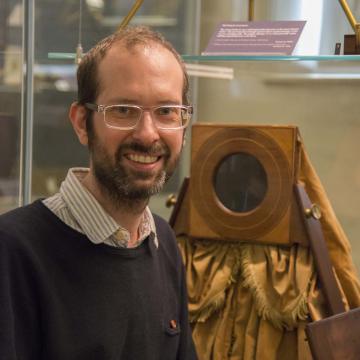Camera obscura
Scott Billings explores how this 'magical box' captured the outside world and became the starting point for all photography
https://www.youtube.com/embed/cpeOQxtUtWw
Inventory Number: 92218
This object is quite magical
It’s called a camera obscura and it's about 200 years old.
The name comes from the Latin words for 'dark' (obscura) and 'room' (camera).
What is a camera obscura?
With a camera obscura, you can perfectly capture the world around you by projecting what's on the outside down into a darkened space on the inside.
And you don't need a power source.
That means it's not 'magic' — but it is really useful science.
Camera obscura — and before them, pinhole cameras — have been around for several hundred years.
But it wasn't until the early 1600s CE that we were able to manufacture lenses of high enough quality to create more flexible cameras with larger openings (apertures). That meant letting in more light to create brighter, higher-quality images.
Draughtsman and painters would once have used a camera obscura like this for making accurate, detailed sketches of scenes — like landscapes or architecture.
It was particularly useful for capturing perspective — accurately representing the height, width, depth and relative position of what you can see in the 3D world on a 2D flat surface.
How does it work?

Above a rather theatrical-looking curtain that surrounds the darkened chamber, there's a large lens mounted in a wooden panel.
That lens focuses the light from the scene outside down onto a mirror which is held at a 45-degree angle behind it on the inside.
The mirror reflects the rays of light onto a piece of paper — or canvas — laid out flat on the base inside the wooden box.
To see the image, you need to cover yourself with a piece of black cloth to stop any other surrounding light from getting into the box. You'd then trace the outlines of the scene you can see projected onto the paper inside.
And because this camera obscura uses a lens, which creates a relatively large aperture, you get a sharp, colourful image on the paper — like a mini video feed of the outside world.
Who used a camera obscura?

The Music Lesson – Johannes Vermeer
Because the light is bouncing off the mirror, you see the image the right way up. But the lens causes the image to flip (or invert) so it's also the wrong way round.
That meant artists using a camera obscura would have to trace the final image in reverse.
There is plenty of evidence that masters like Canaletto and Rembrandt used the camera obscura — but other artists may have been more secretive.
People still debate whether the Dutch painter Johannes Vermeer used a camera obscura to capture the incredible detail in his exquisite paintings of domestic scenes. Although there's no written evidence to prove it either way, art historians think, on balance, that he probably did!
The birth of photography
In the 1700s and 1800s CE, the camera obscura was also a useful accessory for the wealthy taking the ‘Grand Tour’ to make drawings of Italian landscapes or classical ruins.
But the camera obscura is only focusing and reflecting light — not capturing it.
The next big leap in the 1800s CE was to combine a device like a camera obscura with a material that would alter when exposed to the light — and preserve the image.

View from the Window at Le Gras taken by Joseph Niépce c. 1826/27
That's how this photograph was taken. Called View from the Window at Le Gras, it's the earliest known photograph. The Frenchman Joseph Niépce took it in 1826 or 1827 using a camera obscura and a plate coated with chemicals.
So even though the camera obscura isn't magic — it is rather magical.
With just a hole and some light, we have the starting point for all photography, including — believe it or not — the camera in your phone.





